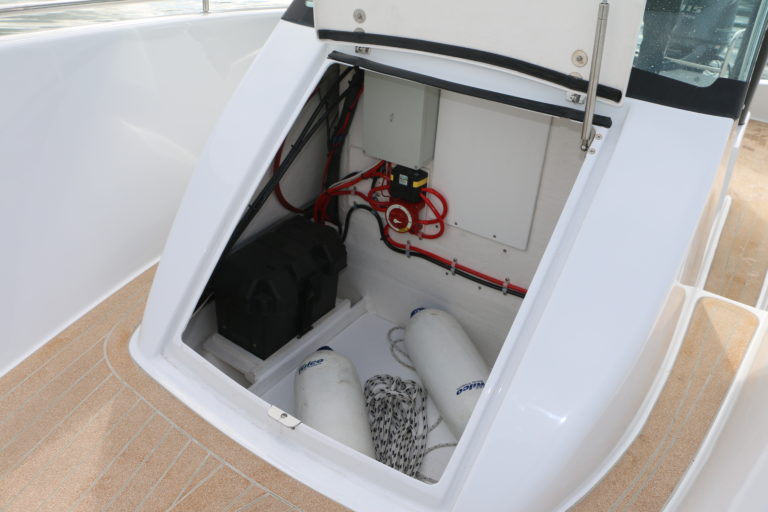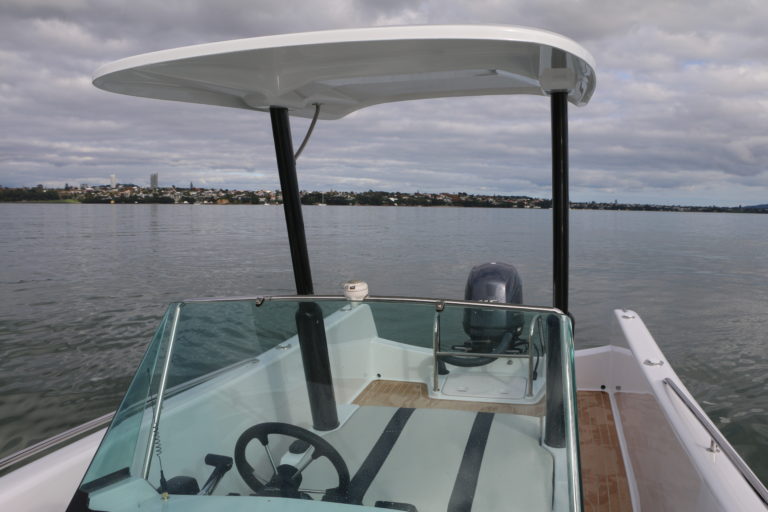What happens when a globally renowned Kiwi yacht designer tries his hand at powerboat design? Well, as Freddy Foote found out, he achieves something quite extraordinary.
Designed by New Zealand yacht designer, Greg Elliott, the EVO 660 isn’t a new boat to the market. It’s been around for around five years and this is the eighth hull to hit the water, all of the previous seven boats dotted around the country.
Elliott isn’t widely known in power boating circles and he’s the first to admit that. However he has been designing some of the best yacht hulls to leave our shores for about 40-years, so is more than qualified to know a thing or two about simple water dynamics, efficiency and how to get the best from a hull as it glides through the water.
“With the yachts, I’ve spent years doing development and research on design and construction, tank testing and modelling to achieve hull designs that not only perform in cruising and racing conditions,” says Elliott.
“With the powerboat, we’ve brought in that same process. So initially, we built the first boat out of plywood, making changes to the hull shape as we went along. This hull is Mk5, and we’ve concentrated on the bottom shape up to the chines. We’ve also experimented a lot with the strakes and the width of the chines to get the ride right.”
Having perfected the design of his hull, Elliott then switched his attention to the layout.

“Everyone is New Zealand is obsessed with having a cabin. I just thought it was a bit of wasted space, so I wanted to do something different and create a layout that could lend itself as a true all-rounder.”
He wanted to design a boat that wasn’t just about fishing, but one that could serve the water sports enthusiast equally as well.
“The main thing I wanted to incorporate was having the full use of the whole boat, not just half of it, so that’s why we went away from a traditional cabin style and made it a centre console, says Elliott.”
The construction of the Elliott EVO 660 is a fibreglass hull and deck, with the inner deck liner built as a single piece. The plugs for the mould were all CNC cut, to ensure precise accuracy during construction. The cockpit is also self-draining, so any water that does find its way on board will quickly disperse.
Open Layout
In the bow, there is very generous aft facing seating in the form of a large upholstered squab with the anchor locker located below. For passenger comfort, there is a handrail that leads along the top of the coaming.
Opposite and facing forward, is a further upholstered seat that could accommodate two adults. Below this, is plentiful storage under the helm console – ideal for bags, extra lifejackets and towels.
Aft, the transom has quite a low profile, which will certainly suit itself to a number of scenarios. Great for water sports and gaining entry in and out of the boat via the sizeable boarding platforms on either side of the outboard. Game fishermen will also love the ease at which they could bring larger fish onboard and into the cockpit.

There is a large storage locker in the cockpit, and the entire floor of the boat is finished with an optional cork finish – though you can specify whatever your preference at the time of build.
At the helm, the dash is neat and tidy with the engine instruments flush mounted into the dash. There is a small glove box to store smaller items and enough room to fit a multi-function display with a VHF radio located below.
What is a first for a New Zealand boat, is the adjustable targa top. At the press of a button on the dash, the GRP targa top above lowers down to the height of your choosing or flush with the top of the windshield. It can go from fully lowered to fully extended in around 25 seconds.

I thought the retractable roof system was incredibly innovative. Not only did it add an extra element of functionality while on the water, but it has benefits off the water. It provides easy storage in a garage and also cuts down on wind drag when towing the trailered boat on the open road.
The optional retractable roof comes at the cost of $9000 with a conventional targa top also offered.
Efficient Hull
The hull design of the EVO 660 is all about efficiency and moderate horsepower. Our test boat was fitted with a Yamaha 115hp four-stroke outboard with a 16” propeller.
I’ve never been on a craft that performs the way that the 660 EVO does. First off, when you put the throttle down, it doesn’t drag the hull in the water as it works to get up on the plane like a like of other boats. The 660 transitions seamlessly onto the plane at a very low speed and just 7 knots will see you planning. At 7.0 knots @ 1500rpm, the Yamaha 115hp four-stroke is using just 3.4 lph.
At 12 knots on Auckland’s inner harbour we were sitting at 3000rpm using 10.7 lph and given that we were up on the plane, we were able to maintain brilliant control of the 660 in Auckland Harbours low-speed zone.
While the 660 is easily powered, with the 115hp four-stroke. A 150hp would be the absolute most you would need, mainly because the hull is just so damn efficient. A 90hp would be fine, but I think the 115hp is the perfect engine for the hull.
The 115hp engine packaged with the 660 makes it pretty much foolproof boating. Someone with very little boating experience would easily be able to take this out for a day on the water and be able to master it very quickly.

Comfortable Driving
Driving the EVO 660 was an absolute pleasure. I found the seated position suited me best, allowing me to sit down snuggly behind the windshield, with plenty of visibility forward. The standing driving position was also excellent, affording plenty of visibility forward over the windscreen and the engine throttle control to the right was within easy reach.
This is a great boat for exploring the Hauraki Gulf or wherever you may be. In summer you can have the Targa top up and enjoy the warm breeze in your face. In winter, hunker down and sit snuggly down behind the windshield with the targa top down keeping you well protected from the nasty bite of winter.
Depending on how you wish to fit out your EVO 660, you can get one on the water for as little as $64,900, – the one as tested was $73,900Variable – and for that price, it’s a lot of boat for the money.
Overall, I loved the EVO 660. It’s a boat that is going to be very adaptable to so many uses. It will make a great boat for families to use on general days out on the water, while at the same time it can be customised to be a well-appointed fishing machine or in turn a versatile superyacht tender.
It’s not too often that something innovative comes along. The EVO 660 achieves new levels of innovation in not only hull design and efficiency but also functionality and configuration.




